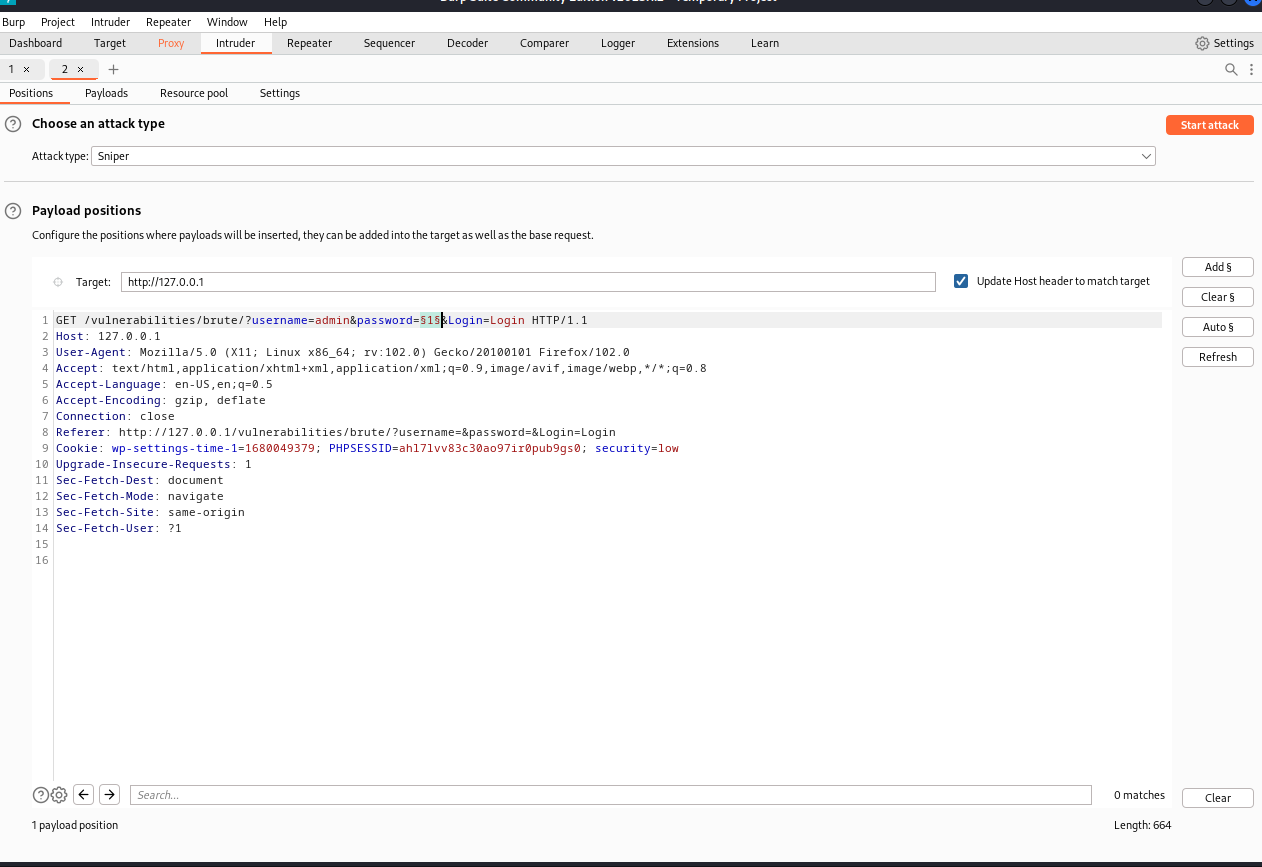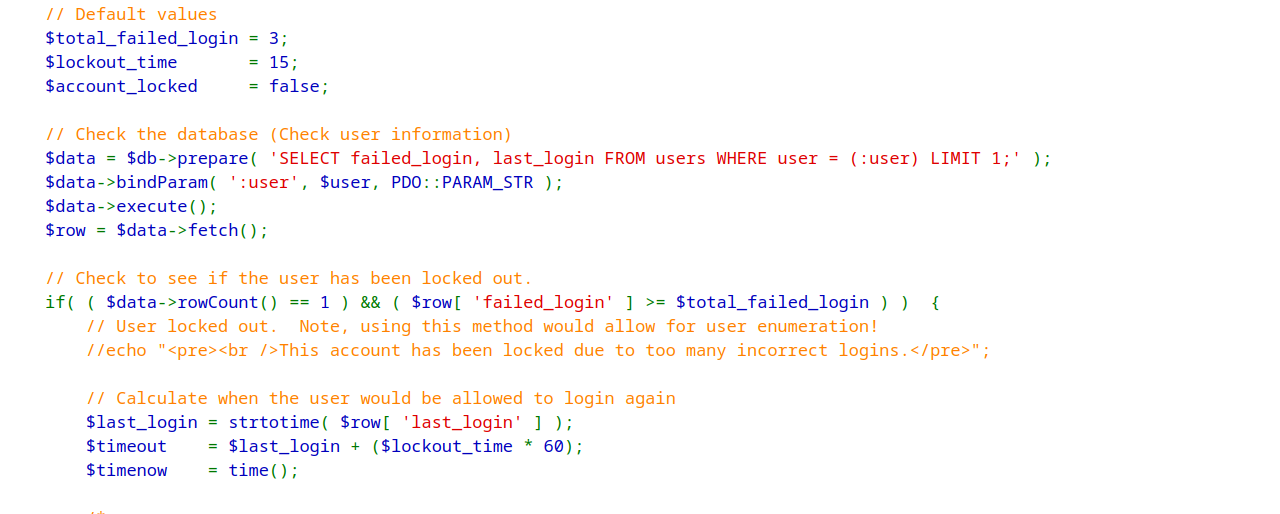Brute Force Report
Brute Forcing DVWA Login Page
Table of Contents
- Outline
- Vulnerabiltiy Explanation
- Proof of Concept - Making use of Hydra and Burpsuite
- Developing a Tool
- Mitigating Brute Force Attacks
Outline
The goal of this write-up is to document the brute force attack performed against the login system of DVWA (Damn Vulnerable Web Application). The objective of this attack was to gain unauthorized admin access through brute-forcing passwords against the admin account. This was conducted as an individual study project hosted by Grootboan Security. Theis report mocks a penetration testing report and a debriefing situation to a client with follow up questions. The presentation of this report can be found here
| Information | Explanation |
|---|---|
| Name | User Authentication Brute Force |
| Severity | High |
| CVSS | 8.1 |
| Path | http://127.0.0.1/vulnerabilities/brute/?username=admin&password=1234&Login=Login |
The base CVSS was calculated upon the following metrics.
| Base Metrics | Explanations |
|---|---|
| Attack Vector (AV) | Network(N) The vulnerability can be exploited remotely over a network connection. |
| Attack Complexity (AC) | Low (L) The vulnerability is straightforward and requires minimal or no special knowledge. |
| Privilege Required (PR) | Low (L) The attack requires some privilege. The user has to login to DVWA webpage to conduct the exploit |
| User Intercation (UI) | None (N) The vulnerability can be exploited without any user interaction. |
| Scope (S) | Unchanged(S:U) An exploit can only affect the specific system |
| Confidentiality Impact (C) | Medium (M) The vulnerability has medium impact on the confidentiality of information. |
| Integrity Impact (I) | High (H) The vulnerability has a signigicant impact on the integrity of the information |
| Availability Impact (A) | High (H) The vulnerability has a significant impact on the availability of the system or resource. |
Vulnerabiltiy Explanation
A brute force attack systematically tries out all possible combinations of passwords or usernames on a system until valid credentials are found. The purpose of a brute force attack is to gain unauthorized access to a system. This not only risks the loss of sensitive data but also opens the possibility of privilege escalation for the attacker. If the compromised credentials have admin-level access, it could result in a complete takeover of the system.
The DVWA /vulnerabilities/brute URL is vulnerable to user authentication brute force attacks, as it lacks adequate security measures.
The tester was able to successfully obtain the password for the admin account and gain access to the Protected Admin Area
Proof of Concept
For POC, the tester has made use of the Hydra tool for brute forcing the following login page.
 In order to use Hydra, the team figured out that the login was using a http-get-form. The team also knew that the user is
In order to use Hydra, the team figured out that the login was using a http-get-form. The team also knew that the user is admin. The team has made use of the famous rockyou.txt password list for the brute force attack.
hydra -l admin -P /usr/share/wordlists/rockyou.txt 127.0.0.1 http-get-form '/vulnerabilities/brute/:username=^USER^&password=^PASS^&Login=Login:H=Cookie\:PHPSESSID=9sosvqo963thpd5jqf9mum3f41; security=low:F=Username and/or password incorrect'
Using the credential, password we were able to sucessfully login to the protected Admin Area

During the penetration test, we have encountered some false positive results from hydra which could be seen below. However upon further investigation, it turned out that without supplementing cookie values such as the security level or PHP session ID to hydra, it provided false positive outcomes \
The testers then used the tool named BurpSuite to conduct the same brute force attack.

First, the testing team intercepted the HTTP login request. Then, the request was sent to the intruder tab. The testers used the sniper mode and specified the password GET parameter to contain the payload, which was the 500-worst-password.txt wordlist from Seclists.
/usr/share/wordlist/seclists/Passwords/Common-Credentials/500-worst-password.txt

Upon conducting the brute force attack, the testing team found that password has a length that is different from the other passwords. Looking at the response we see that we were sucessfully able to login into the protected area admin

Developing Python Tool
To automate the attack and practice programing in python, we have created python script that automates the attack.
The python script can be found in the following link.
Kwang Brute Force Tool
We can see that upon running the code, we were able to sucessfully brute force password for user admin

Mitigating Brute Force Attacks, its benefits and downside
The brute force attack was mainly possible due to lack of secure coding.
There are various ways to mitigate brute force attacks.
Strong passwords without password reuse
Creating a strong password with multiple combinations of special characters and a minimum length of at least 15 characters can help prevent brute force and dictionary attacks. Additionally, avoiding password reuse across different accounts or platforms makes it more difficult for attackers to succeed using leaked credentials.
MFA (Multi Factored Authentication)
Multi-Factor Authentication is an authentication method that requires the user to provide two or more verification methods. This includes methods such as password + fingerprint (biometric) or password + PIN code. The most common form of Multi-Factor Authentication is 2FA (Two-Factor Authentication).
Although MFA provides maximum security, different types of MFA methods could be bypassed through social engineering techniques such as phishing attacks, response manipulation, pass-the-cookie attacks, and more. Additionally, implementing heavy MFA may also reduce user usability if MFA is required every time during login. Moreover, heavy MFA may also reduce user usabiltiy if MFA is required everytime upon login.
Account Lockout
Another method is account lockouts after specific time frame. The below image shows the php code for the impossible level DVWA.
 It is common for systems to implement an account lockout policy where, if a user attempts more than three wrong passwords, the account gets locked out. This mechanism helps prevent brute force attacks. However, account lockout methods can be vulnerable to password-spray attacks, also known as low-and-slow methods, where the attacker attempts a common password over a long span of time after each attempt.
It is common for systems to implement an account lockout policy where, if a user attempts more than three wrong passwords, the account gets locked out. This mechanism helps prevent brute force attacks. However, account lockout methods can be vulnerable to password-spray attacks, also known as low-and-slow methods, where the attacker attempts a common password over a long span of time after each attempt.
Furthermore, a strict lockout policy has another downside: it can lead to intentional account lockouts by attackers. This intentional lockout can hinder user usability and accessibility \
Captcha
Captcha is a program or system intended to distinguish human from machine input. This can be useful from distinguishing a brute force attack (machine). The below image is an example of captcha, demonstrating the need for human interaction.

Conclusion
In conclusion, while implementing various security measures can be demanding for users, it is imperative to understand the significance of combining these methods to fortify our defenses against brute force attacks. By embracing a multi-layered approach to authentication, including strong passwords, multi-factor authentication, and account lockout policies, we demonstrate a proactive stance in safeguarding our sensitive information.
References:
Grootboan Security
MFA BYPASS